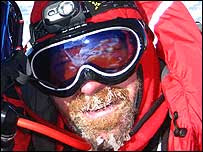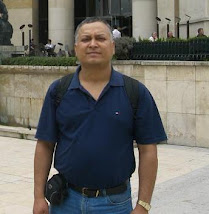 Medical tests on top of Everest
Medical tests on top of Everest
By Kay Mitchell
Project Manager, Caudwell Xtreme Everest
A team of doctors and nurses has just returned from climbing Mount Everest where they carried out extensive research at altitude designed to improve the treatments of patients in intensive care.
carried out extensive research at altitude designed to improve the treatments of patients in intensive care.
Tackling the Hillary step on the approaches to the summit is most difficult task. Hilary step is the final impediment in conquering the Everest named after the first climber of Everst Sir Edmund Hilary. There is a famous quotation from Reinhold Messner, who in 1978 with Peter Habeler became the first man to climb Everest without supplemental oxygen: "I am nothing more than a single narrow gasping lung, floating over the mists and summits."
Climbing Everest is hard enough, but we were also using it as a laboratory to investigate our understanding of critically ill patients with ourselves as guinea pigs.
The project was designed to discover why some people are better able to cope with a lack of oxygen than others.
a lack of oxygen than others.
By taking blood and tissue samples from each other and undertaking extreme exercise at a series of high altitude "laboratories", we hoped to replicate the problems of patients in intensive care, who suffer similar low oxygen levels to the climbers on Everest.
The findings now being analysed will be used to improve intensive care treatment for patients suffering from a range of life-threatening conditions including blue babies, congenital heart disease, chronic bronchitis, cystic fibrosis etc.
Base Camp
I lived at Everest Base camp for 2 months, supporting the team as they climbed the mountain. The base camp sits on the Khumbu glacier in the Himalayas at 5300m altitude. At this height, there is half the oxygen available to breathe that there is at sea level.
The temperature fluctuates from around -20 degrees centigrade at night to +20 degrees centigrade during the day when the sun is out. Normally, the Sherpas bring you hot tea to your tent as an early morning wake up call, when the temperature is still well below freezing.
Unfortunately, for up to 75 days in a row, we had to avoid any drinks apart from water until we had performed 30 minutes of tests on ourselves, known as the "daily diary".
I am not good without caffeine first thing in the morning! And stripping down to a short sleeved T shirt to measure your blood pressure in below freezing temperatures is unspeakable!
Weight loss :
Even without the tests, we found out a great deal about what it means to live in an oxygen poor environment. Almost all the team lost weight. One person lost 3 and a half stone (20kg)! The longer I spent at base camp, the more I lost my appetite, until I force fed myself at every meal.
I was lucky. Some of the team took part in a meal study. They had to weigh everything they ate for 24 hours, and meticulously record its nutritional content. If they could not work that out, then they were not allowed to eat it. During this time they had to keep all their urine and excrement for analysis back in the UK. (The joys of defecating into a plastic bag!). At sea level you stop because your legs get tired, but high on the mountain it is the breathlessness that stops you .
Mike Grocott, Expedition Leader
We were trying to work out why people lose weight at altitude, and whether it is more muscle than fat - this rapid weight loss is a particular concern for sick patients in intensive care.
Higher up the mountain it was much worse! Mike Grocott, the expedition leader (Intensive care Consultant at the Whittington Hospital in North London, and Senior Lecturer at UCL ), describes feeling so breathless after doing an exercise bike test at 8000m (850m below the summit).
"I felt like I was suffocating, even though my legs did not feel tired. At sea level you stop because your legs get tired, but high on the mountain it is the breathlessness that stops you."
This could be how a patient with breathing difficulties feels just before they are put on a ventilator.
When a needle was inserted into the artery in his groin at 84 57m, he felt a stabbing pain in his gut. Yet, this experience was not as bad as the tests he underwent when he got back down to base camp.
"I have never been bothered by needles before. But I started to hate them more and more as the weeks went on. I found the final sets of tests after summiting was almost harder psychologically than summiting itself. This may be how patients feel, who have been in hospital for a long time. It gets harder, not easier!"
Sleep Apnoea
Chris Imray, the deputy climbing leader, and a Vascular Surgeon at the UHCW NHS Trust in Coventry, had one very alarming experience. He was not climbing at the time, but trying to sleep at Camp Two. The exercise bike was used for tests up to an altitude  of 8000m. The low levels of oxygen were causing him to suffer from sleep apnoea. This is a condition where, as a person drifts off to sleep they stop breathing, until their carbon dioxide levels climb, triggering the brain to tell the lungs to start breathing again. This is something experienced by many people at sea level every day for different reasons.
of 8000m. The low levels of oxygen were causing him to suffer from sleep apnoea. This is a condition where, as a person drifts off to sleep they stop breathing, until their carbon dioxide levels climb, triggering the brain to tell the lungs to start breathing again. This is something experienced by many people at sea level every day for different reasons.
"I was trying to get to sleep one night. I would just be nodding off when I would panic, desperately short of breath. I started to try to make myself breathe regularly, so that my oxygen levels did not drop, but this kept me awake. I lay awake for hours, worrying that I might drift off to sleep and never wake up."
But there were also some triumphs. Days later at 8000m, Chris had a eureka moment when he managed to use an ultrasound machine to image one of the main arteries supplying the brain.
This had never been done at this altitude before, and will give the team more information about the supply of oxygen to the brain, when blood oxygen levels are low.
The unpleasant experiences were all worth it though. "This expedition achieved a huge number of firsts." says Sundeep Dhillon, the Climbing Leader, and a General Practitioner , "such as the highest exercise test on a bike ever. The previous record had stood for 40 years."
"All of these successes will contribute to our understanding of how some people adapt to low levels of oxygen better than others. This will help us develop treatments for intensive care patients."
The team are now back in the UK and many of the 47 doctors, nurses and other health professionals have already returned to their regular jobs at GP surgeries or hospitals up and down the UK. Others have stayed on to help process the research and the main body of results is likely to be published around the end of next year.
But none of us will forget our amazing experience on top of the world, and helping to contribute to how some of the most vulnerable patients are treated.
The BBC Horizon team spent three and a half months following the team of doctors on their journey to the summit.
Everest: Doctors in the Death Zone is on BBC Two at 2000BST on Sun 23 & Sun 30 Sept.
Saturday, 22 September 2007
Posted by
Krajend
at
11:26
![]()


































